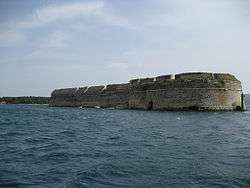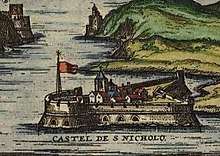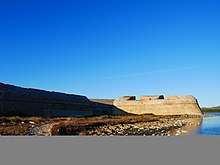St. Nicholas Fortress
| St. Nicholas' Fortress Tvrđava Sv. Nikole | |
|---|---|
| Šibenik, Croatia | |
 | |
 St. Nicholas' Fortress Tvrđava Sv. Nikole | |
| Coordinates | 43°43′19″N 15°51′14″E / 43.722°N 15.854°E |
| Type |
Fortress |
| Site information | |
| Owner | Šibenik, Croatia |
| Controlled by | Republic of Venice |
| Open to the public | Yes |
| Condition | Preserved |
| Site history | |
| Built | 1540.-1547. |
| Built by | Hyeronimus di San Michaela |
| Materials | Limestone |
| Type | Cultural |
| Criteria | iii, iv |
| Designated | 2017 (41 Session) |
| Part of | Venetian Works of Defence between 15th and 17th centuries: Stato da Terra – western Stato da Mar |
| Reference no. | 1533 |
| Region | Europe and North America |
St. Nicholas' Fortress (Croatian: Tvrđava Sv. Nikole) is a fortress located in the town of Šibenik, one of the oldest native Croatian towns on the eastern shores of the Adriatic, in central Dalmatia, Croatia.
It was included in UNESCO's World Heritage Site list as part of "Venetian Works of Defence between 15th and 17th centuries: Stato da Terra – western Stato da mar" in 2017.[1]
Tourists are currently not allowed to enter the fortress, but only explore it from outside. The reason is that the fortress is currently being reconstructed. The reconstruction should be finished till the end of 2018.[2]
History

The town of Šibenik has a fortification system consisting of four fortresses:
- St. Nicholas' Fortress (Tvrđava Sv. Nikole)
- St. Michael's Fortress (Tvrđava Sv. Mihovila)
- St. John's Fortress (Tvrđava Sv. Ivana)
- Barone Fortress (Tvrđava Barone)
Only St. Nicholas' Fortress is at sea, at the entrance to the Šibenik port, and the remaining three are on land.
St. Nicholas' Fortress was built on the left side at the entrance to St. Anthony Channel (kanal sv. Ante), on the island called Ljuljevac. The island is situated at the entrance to the Šibenik channel across the Jadrija beach lighthouse. St. Nicholas' Fortress got its name from the Benedictine Monastery of St. Nicholas, which was originally on the island, but due to the construction of the fortress, it had to be demolished. At the request of domestic Croat population of Šibenik, the Venetian captain Alojzije de Canal decided to build a fort on the island of Ljuljevac on 30 April 1525. The fortress was designed and built by the famous Venetian architect and builder Hyeronimus di San Michaela. It was built by in the 16th century to prevent Turkish boats from reaching the port. St. Nicholas' Fortress was armed with 32 cannons. However, its imposing appearance and size were a bigger threat to the enemy than cannons ever were.
Architecture

The fortress is one of the most valuable and best preserved examples of defense architecture in Dalmatia. It is made of brick because that material was considered to be most resistant to cannonballs, while the foundations are made of stone. Although defense capabilities of the fortress have never been tested in military operations, the structure still proved successful in protecting the city from sea-bound enemy attacks. During the centuries of use, the structure served to various armies and has undergone a number of renovations, some of them necessary only because of the development of arms. It was completely abandoned by the military in 1979 and has been undergoing renovation ever since.
Notes
In the Mediterranean, there are two similar forts: one on the island of Malta, and the other is in Venice; its name is Saint Nicholas.
Image gallery

 St Nicholas Fortress
St Nicholas Fortress View of St. Nicholas Fortress from Jadrija
View of St. Nicholas Fortress from Jadrija Currently, there is no way of entering the fortress from land
Currently, there is no way of entering the fortress from land
References
- ↑ Centre, UNESCO World Heritage. "Venetian Works of Defence between 15th and 17th centuries: Stato da Terra – western Stato da Mar". whc.unesco.org. Retrieved 11 July 2017.
- ↑ "Šibenik Croatia - tourist destinations, information and attractions". www.sibenik-croatia.com. Retrieved 2018-05-14.
External links
| Wikimedia Commons has media related to Saint-Nicholas Fortress in Šibenik. |
